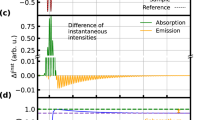Abstract
In recent years, experimental investigations of vibrational relaxation processes have received increasing attention. Interesting information is obtained from the band shapes observed in infrared and Raman spectroscopy [1, 21. The interpretation of the measured lines is difficult, however, since several physical processes contribute in general to the observed band contours. Line broadening factors are: rotational motion, vibrational dephasing, energy relaxation, and inhomogeneous broadening due to a distribution of vibrational frequencies, e.g. isotopic line splitting. Under certain assumptions it is possible to separate the rotational contribution. The rest is sometimes called the “intrinsic vibrational part” and contains the other line-broadening factors. At the present time, one cannot isolate the different contributions by spectroscopic methods. For instance, the population lifetime of an excited vibrational state was unknown until very recently for any vibrational mode in the liquid state. Similarly, the inhomogeneous part of a spectroscopic line is not known in many cases. As a result, the time constants deduced from spectroscopic band contours are not well understood.
Access this chapter
Tax calculation will be finalised at checkout
Purchases are for personal use only
Preview
Unable to display preview. Download preview PDF.
Similar content being viewed by others
References
R.G. Gordon, J. Chem. Phys. 40, 1973 (1964);
R.G. Gordon, J. Chem. Phys. 42, 3658 (1965);
R.G. Gordon, J. Chem. Phys. 43, 1302 (1965).
S. Bratos and E. Maréchal, Phys. Rev. A4, 1078 (1971);
F.J. Bartoli and T.A. Litovitz, J. Chem. Phys. 56, 404, 413 (1972);
G. Döge, Z. Naturforsch. 28a, 919 (1973).
H.S. Goldberg and P.S. Pershan, J. Chem. Phys. 58, 3816 (1973);
W.G. Rotschild, G.J. Rosasco and R.C. Livingston, J. Chem. Phys. 59, 5310 (1973).
For a review see A. Laubereau and W. Kaiser, Ann. Rev. Phys. Chem. 26, 83 (1975).
D. von der Linde, A. Laubereau and W. Kaiser, Phys. Rev. Lett. 26, 955 (1971);
A. Laubereau, Chem. Phys. Lett. 27, 700 (1974).
A. Laubereau, G. Wochner and W. Kaiser, Phys. Rev. A13, 2212 (1976).
A. Laubereau, D. von der Linde and W. Kaiser, Phys. Rev. Lett. 28, 1162 (1972).
R.R. Alfano and L.L. Shapiro, Phys. Rev. Lett. 29, 1655 (1972).
A. Laubereau, K. Kirschner, and W. Kaiser, Opt. Commua. 9, 182 (1973);
A. Laubereau, G. Kehl, W. Kaiser, Opt. Commun. 11, 74(1974).
A. Laubereau, A. Seilmeier and W. Kaiser, Chem. Phys. Lett. 36, 232 (1975).
For a more detailed discussion see A. Laubereau and W. Kaiser in “Chemical and Biochemical Applications of Lasers”, ed. C.B. Moore, vol. 2, Academic Press (New York 1977 ).
S.F. Fischer and A. Laubereau, Chem. Phys. Lett. 35, 6 (1975);
P.A. Madden and R.M. Lynden-Bell, Chem. Phys. Lett. 38, 163 (1976).
A. Laubereau, G. Wochner and W. Kaiser, Chem. Phys. in press
S. Bratos, J. Chem. Phys. 63, 3499 (1975).
W.G. Rotschild, J. Chem. Phys. 65, 455 (1976).
W.G. Rotschild, ibid 65, 1958 (1976).
G.C. Pimentel and A.L. McClellan, “The Hydrogen Bond”, Freeman (San Francisco, 1960); Ann. Rev. Phys. Chem. 22, 347 (1971).
N. Koizumi, J. Chem. Phys. 27, 625;
H. Fellner-Feldegg, J. Phys. Chem. 73, 616 (1969).
K. Spanner, A. Laubereau and W. Kaiser, Chem. Phys. Lett. 44, 88 (1976).
Author information
Authors and Affiliations
Editor information
Editors and Affiliations
Rights and permissions
Copyright information
© 1978 Plenum Press, New York
About this chapter
Cite this chapter
Laubereau, A., Kaiser, W. (1978). Picosecond Laser Techniques. In: Dupuy, J., Dianoux, A.J. (eds) Microscopic Structure and Dynamics of Liquids. NATO Advanced Study Institutes Series, vol 33. Springer, Boston, MA. https://doi.org/10.1007/978-1-4684-0859-1_8
Download citation
DOI: https://doi.org/10.1007/978-1-4684-0859-1_8
Publisher Name: Springer, Boston, MA
Print ISBN: 978-1-4684-0861-4
Online ISBN: 978-1-4684-0859-1
eBook Packages: Springer Book Archive




